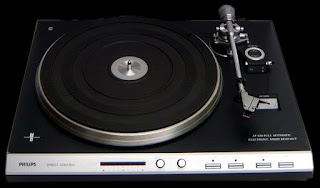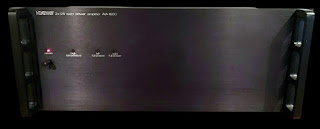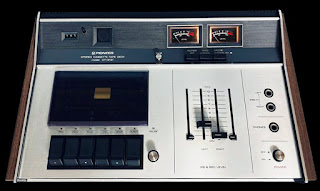Impulse Noise
Reduction System
Ever since the
invention of the recorded disc, annoying "clicks" and
"pops" caused by scratches, static, and other imperfections, have
consistently disturbed the listening pleasure of mysic lovers. Now, SAE
introduces the unique model 5000, an Impulse Noise Reduction System which
eliminates those unwanted sounds with no adverse effect on the quality of the
recorded material.
This break-through
in electronic circuitry is so demonstrably effective, that the SAE 5000 is
destined to beacome an essential part of any sound system.
The SAE 5000 is
compact and sleek, built to SAE's exacting standards, and ready to enhance the
performance of any system, from the standard receiver/turntable combination to
the most sophisticated audiophile components.
Before the
technological break trough achieved by the 5000, there were many records that
offered less than ultimate performance and some which were rendered virtually
unlistenable due to the presence of impulse noise. Impulse noise is generated
by static discharge, record blemishes or accumilation of dirt, and is often
referred to as "clicks" and
"pops". Now, with the 5000, most of these problems can be overcome.
Many virtually lost recordings can be played again with their fidelity unnamed
by impulse noise. Ofcourse, unblemished recordings can be played without being
adversely affected by the 5000. only sounds which are detected as impulse noise
are eradicated. All else remains. Old recordings, even 78 rpm's may be
rejuvenated by our new system.
The circuitry in the
SAE 5000 is the result of extensive research and evaluation by its inventor,
Jack Sacks, into the field of impulse noise.
At the start of
research a careful statistical analysis was made of impulse noise and those
properties which are unique to it. From this information a logic circuit was
developed for the 5000 which constantly monitors the music, searching for those
unique parameters which indicate the
presence of impulse noise. Upon detection of the presence and duration of the
offending impulse, which is accomplished by examining the shape of the
"spike", and other parameters, the noise removal circuit comes into
play which deletes pnly the damaged segment from the sound sequence. Because
the duration of this impulse noise is usually so minute, (less than one
thousandth of a second), it is possible to extrapolate forward a tiny segment
from the music information immediately preceding the gap and thus maintain
total continuity and integrity at the same time. This technique is undetectable
to the ear and does not adversely affect the frequency response, dynamic range,
or spectral balance of the music. The system remains passive and
"transparent" at all times, doing its job only when called upon by
the detection of unwanted noise.
The SAE 5000 has
simple and effective controls. The principal control is a threshold adjustment
which varies the sensitvity of the detection circuit. Different record
characteristics may require some sensitivity adjustment.
There is a system
defeat button which allows the Impulse Noise Reduction (INR) circuit to be
bypassed electrically. A tape monitor switch and rear mounted jacks reconnect
the tape monitor circuitry used to hook up the 5000.
Finally, the
incredible effectiveness of the INR system can be demonstrated by activating
the Invert switch. This action reverses the active circuitry and you are now able to hear Only the noise your
system eliminates while in the operating model.
Specifications:
Total Harmonic
Distortion (at any level to rated output from
20 Hz to 20 kHz): less than
0.1% Intermodulation Distortion (at any
level or rated output with any 2 mixed
frequencies between 20 Hz to 20 kHz at
4/1 Voltage Ratio): less than 0.1%
Signal-to-Noise
Ratio: greater than 90 dB (below rated
output)
Rated Output: 2.50 Volts RMS
Frequency
Response: ±1 dB (20 Hz to 20kHz)
Output at Clipping: greater
than 9 Volts into 10 K Ω
Input Impedance: 75 K Ω
Input Impedance: 75 K Ω
Output Source Impedance: 500 Ω
Output Lead Impedance: 600 Ω (minimum)
Insertion Loss: less than 1 dB
Insertion Loss: less than 1 dB
Power Supply /
Consumption: 110-125 VAC, 50 Hz to 60 Hz
/ 7 watts
Dimensions (W x H x
D): 10.75" x 3" x
9.25"
Shipping
Weight: 8 Ibs.
Rack
Mount Kit available
























